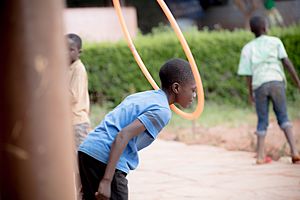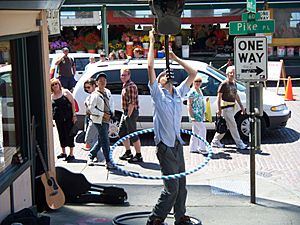Hula hoop facts for kids
| Type | toy |
|---|---|
| Company | various |
| Country | various |
| Availability | Ancient times–present |
| Materials | various |

A hula hoop is a toy hoop that you can spin around your waist, arms, legs, or neck. People have played with hoops for thousands of years, but the plastic hula hoop became a huge hit in the 1950s.
The name "hula hoop" was created by Joan (Constance Manning) Anderson. It was inspired by the hip-swaying movements of the Hawaiian hula dance.
Hula hoops for children are usually about 70 centimetres (28 in) wide. Hoops for adults are bigger, around 100 centimetres (39 in) wide. Today, most hoops are made of plastic, but the very first ones were made from natural things like willow branches, rattan vines, and stiff grasses.
Contents
A Toy Through History
Hoops have been around for a very long time. They were used by children and adults as far back as 500 BC. In 14th-century England, people enjoyed playing with wooden and metal hoops.
The first toy store in the world, Hamleys, sold hula hoops when it opened in London way back in 1760.
Native American Hoop Dance
The Native American Hoop Dance is a special kind of storytelling dance. A dancer uses many hoops to create different shapes. These shapes can look like animals or symbols that help tell a story. Usually, one person performs this dance with several hoops at once.
The Plastic Hoop Craze
The hula hoop became world-famous in the late 1950s. This happened after the Wham-O toy company in California started selling a plastic version.
The idea for the plastic hoop came from Australia. An Australian toy maker named Alex Tolmer saw that kids loved playing with bamboo hoops. He decided to make them out of a new, lightweight plastic called Polyethylene. In 1957, his company, Toltoys, sold 400,000 plastic hoops in Australia.
Wham-O heard about this success and created their own version. They made their hoops from a plastic called Marlex. In the summer of 1958, a "hula hoop craze" swept across the United States. In just four months, 25 million plastic hoops were sold! Within two years, sales reached over 100 million.
The toy was so popular that it was added to the National Toy Hall of Fame in 1999.
Hooping Today
In the 1990s, hula hooping became popular again, especially among adults. People started calling it "hoopdance" or "hooping." It is now a fun activity at festivals and fairs all over the world. Many people see it as a great way to exercise and have fun.
Modern Hoops
Today's hoops are very different from the simple plastic rings of the 1950s.
- DIY Hoops: Many hoopers make their own hoops from PVC piping or a type of plastic called polypropylene.
- Size and Weight: Heavier and larger hoops are good for beginners because they spin more slowly. Lighter and thinner hoops are better for fast hand tricks.
- Cool Designs: Hoops can be decorated with colorful tapes. Some tapes even glow in the dark or sparkle.
- LED Hoops: Some hoops have LED lights inside them. They can light up and create amazing patterns in the dark. There are even "Smart Hoops" that you can program with a phone app to create special effects.
Hooping as a Skill
Modern hooping involves a lot of cool tricks. These include "on-body" moves, where the hoop spins on your body, and "off-body" moves, where you spin it with your hands. Some tricks include isolations (making the hoop look like it's floating) and using two or more hoops at once.
Hooping is also a popular fitness activity. There are hooping classes in many cities where you can learn new moves and get a good workout. For an extra challenge, some people use weighted hula hoops for exercise.
For performances, there is even fire hooping. Performers use special hoops with wicks attached that can be safely set on fire, creating a stunning visual effect.
See also
 In Spanish: Hula hoop para niños
In Spanish: Hula hoop para niños



